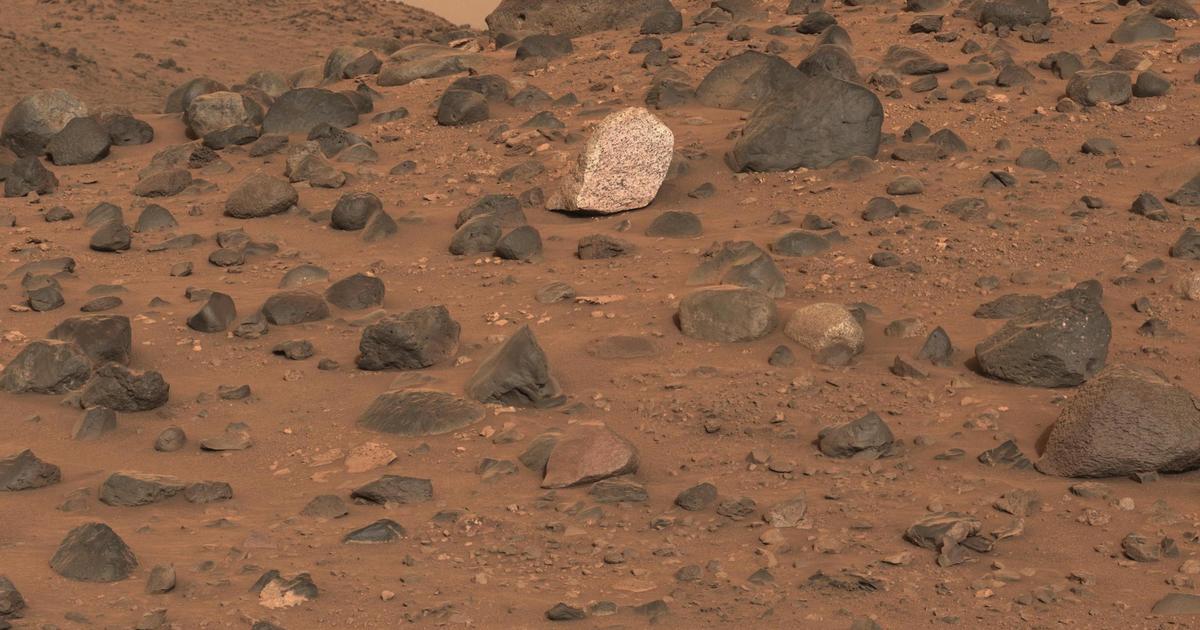While exploring a crater on Mars that may give scientists insights into life that potentially once existed there, NASA said its Perseverance rover made an unprecedented discovery. The rover, which landed on the Red Planet in 2021 specifically to probe the ancient Jezero crater, found a mysterious light-toned boulder earlier this month that was the first of its kind seen on Martian land.
Perseverance encountered the boulder while traversing the Neretva Vallis, a dried river delta that flowed into the crater billions of years ago, on its way to an area inside the rim where rocky outcrops are being examined for sediment that could shed light on Mars’ history, said NASA. The rover had changed course along its route to avoid rough terrain when, traveling a short cut through a dune field, it reached a hill that scientists have dubbed Mount Washburn.
The hill was covered with boulders, some of which NASA described as belonging to “a type never observed before on Mars.”
One small boulder particularly intrigued the scientists working with Perseverance from Earth. Measuring roughly 18 inches across and 14 inches tall, the speckled and conspicuously light-toned rock was spotted among a field of darker boulders on the hill.
NASA/JPL-Caltech/ASU/MSSS
“The diversity of textures and compositions at Mount Washburn was an exciting discovery for the team, as these rocks represent a grab bag of geologic gifts brought down from the crater rim and potentially beyond,” said Brad Garczynski of Western Washington University, who co-leads the current Perseverance mission, in a statement. “But among all these different rocks, there was one that really caught our attention.”
Garczynski and his team nicknamed the mysterious boulder Atoko Point, and a deeper examination of the rock using the rover’s instruments suggested that it was composed of the minerals pyroxene and feldspar. NASA said the size, shape and overall arrangement of minerals in Atoko Point, as well as the potential composition of the boulder on a chemical level, put the rock “in a league of its own” in terms of Martian sediment, at least among those already known to scientists.
Pyroxene and feldspar are minerals also found in the Earth’s crust and on the moon, according to the U.S. Geological Survey and NASA. The space agency said that some scientists on the Perseverance team speculated that the minerals detected on Atoko Point may have come from magma that originated below the surface of Mars and became exposed on the rim of the Jezero crater over time because of erosion.
Other members of the team suggested that the boulder may have appeared out of place on Washburn Hill if it was really produced on a different part of the planet and moved with the ancient river channel to its present location on the rim. But NASA said all of the Perseverance scientists believe that more rocks with a similar composition must exist elsewhere on Mars.
NASA/JPL-Caltech
The rover discovered Atoko Point in the midst of its fourth “campaign” on Mars, which focuses on finding evidence of carbonate and olivine deposits in the interior of the Jezero crater. Both groups of minerals exist on Earth, with carbonate typically found in deposits near the shores of lakes and olivine typically associated with volcanic activity.
They are of interest to scientists studying Mars —and they’ve both been observed already by Perseverance— because of their abilities to encapsulate remnants of the past for long periods of time. Identifying carbonate in the Martian crater could theoretically give scientists access to traces of ancient life on the planet preserved within the mineral itself, and olivine helps them understand when in history the Martian climate may have been conducive to organic compounds, like flowing water, and, potentially, life.
Scientists say that learning about the makeup of Mars, and what it may have been like long ago, could help them figure out whether the planet’s current landscape could ever be habitable for humans. It could also offer important clues about the origins and evolution of life on Earth.


